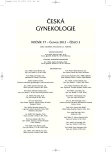Trends in vaginal assisted deliveries in the Moravian-Silesian region between the years 2002-2011
Authors:
O. Šimetka 1
; P. Velebil 2
Authors‘ workplace:
Porodnicko-gynekologická klinika, LF OU a FN Ostrava, přednosta MUDr. O. Šimetka, Ph. D.
1; Ústav pro péči o matku a dítě, Praha, ředitel doc. MUDr. J. Feyereisl, CSc.
2
Published in:
Ceska Gynekol 2012; 77(3): 232-236
Overview
Objective:
To analyze trends in vaginal assisted deliveries between 2002-2011 in the Moravian-Silesian region, Czech Republic.
Design:
Retrospective analysis.
Setting:
Obstetric facilities in the Moravian-Silesian region, Czech Republic.
Methods:
Analysis of data on vaginal assisted deliveries in the obstetric facilities in the Moravian-Silesian region, Czech Republic, between the years 2002–2011.
Results:
During the analyzed period the use of vacuumextraction rose from 0.11% to 2.44% of all deliveries and the use of forceps declined from 1.54% to 0.24% of all deliveries. The overall frequency of vaginal assisted deliveries increased from 1.65% to 2.87%. The frequency of caesarean section increased from 16% to 24.5%.
Conclusion:
A fundamental change in the trends of vaginal assisted deliveries occurred in the Moravian-Silesian region between 2002 to 2011. There was a significant reduction in the use of forceps and the rise in the use of vacuum extraction with an overall increase in vaginal assisted deliveries. In comparison with the results of the rest of the Czech Republic, the trends in the Moravian-Silesian region are more pronounced. During the analysed period a significant rise of the cesarean section deliveries occured.
Key words:
vaginal assisted delivery, vacuumextraction, forceps, trend.
Sources
1. Johanson, RB. Menon, V. Vacuum extraction versus forceps for assisted vaginal delivery (review). Cochrane Database of Systematic Reviews 1999, Issue 2. Art. No. CD 000224. DOI: 10.1002/14651858.CD000224.
2. Johnson, J., Figueroa, R., Garry, D., et al. Immediate maternal and neonatal effects of forceps and vacuum-assisted deliveries. Obstet Gyn, 2004, 103(3), p. 513–518.
3. Miksovsky, P., Watson, W. Obstetric vacuum extraction: State of the art in the new millenium. Obstet Gyn Survey, 2001, 56(11), p. 736–751.
4. NHS Maternity Statistics, England 1980-2010. Method of delivery, 2012 [www.ic.nhs.uk]. Accessed 9 January 2012.
5. Samuelsson, E., Ladfors, L., Wennerholm, UB., et al. Anal sphincter tears: prospective study of obstetric risk factors. Br J Obstet Gynaecol, 2000, 107, p. 926–931.
6. Strachan, BK., Murphy, DJ. Operative vaginal delivery, RCOG, Guideline No. 26, revised October 2005.
7. Šimetka, O., Michalec, I. Vakuumextrakce. Čes Gynek, 2010, 75 (5), s. 417–422.
8. Vacca, A. Trials and tribulations of operative vaginal delivery. BJOG, 2007, 114, p. 519–521.
9. World Health Organisation. Appropriate technology for birth. Lancet, 1985, 2(8452), p. 436-437.
Labels
Paediatric gynaecology Gynaecology and obstetrics Reproduction medicineArticle was published in
Czech Gynaecology

2012 Issue 3
Most read in this issue
- Impact of oxidative stress on male infertility
- Peripartal hysterectomy – review
- The influence of maternal age, parity, gestational age and birth weight on fetomaternal haemorrhage during spontaneous delivery
- Sever bleeding one year after a cesarean section caused by placenta increta persistens
